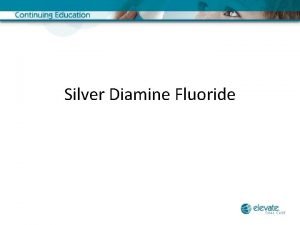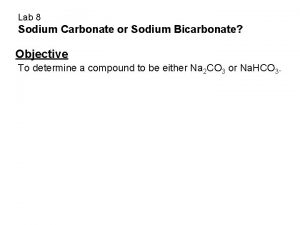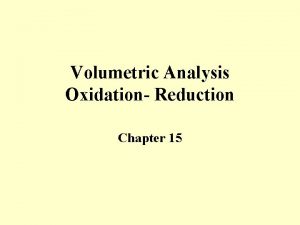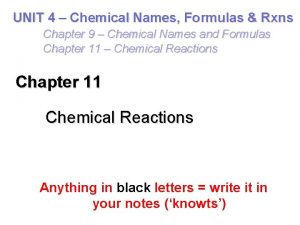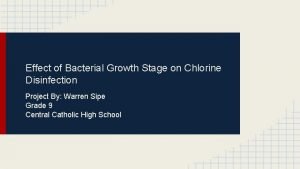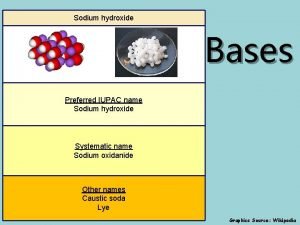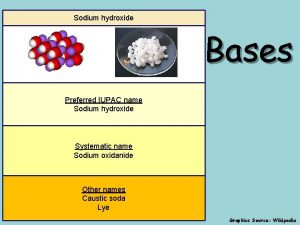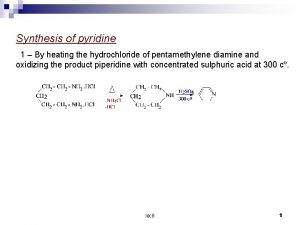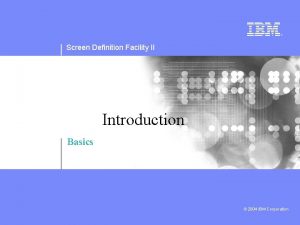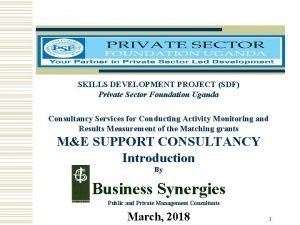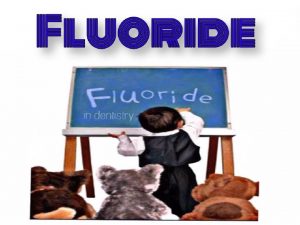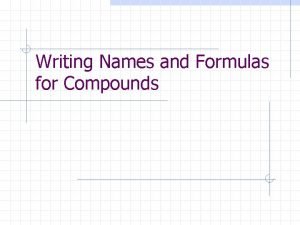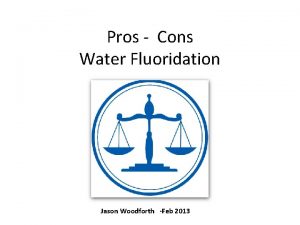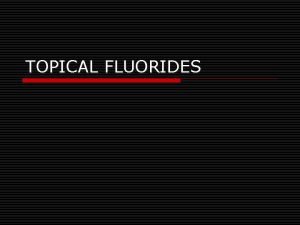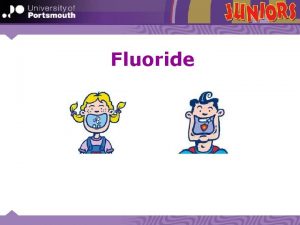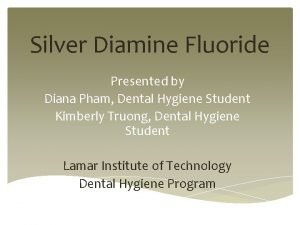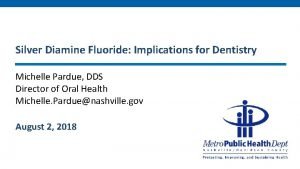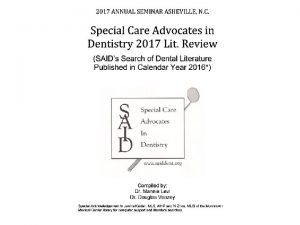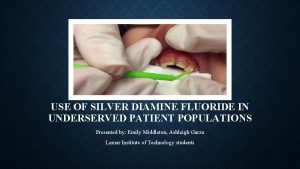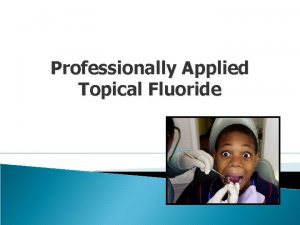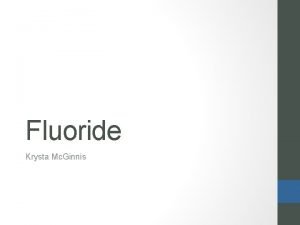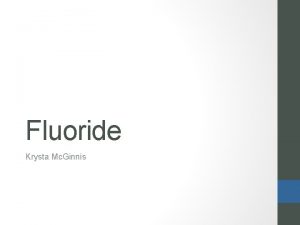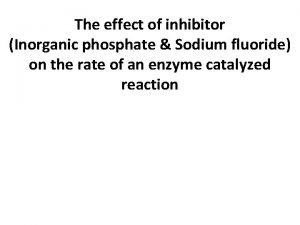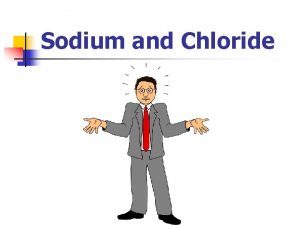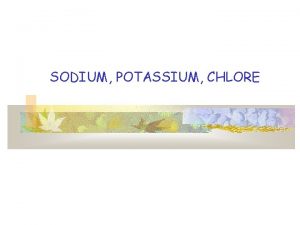Sodium Diamine Fluoride SDF TREATMENT AND OUTCOMES PRESENTED
















- Slides: 16

Sodium Diamine Fluoride (SDF) TREATMENT AND OUTCOMES PRESENTED BY TRISTAN GALLOWAY, DDS

SDF Silver diamine fluoride is an inexpensive topical medicament used extensively in other countries to treat dental caries across the age spectrum. No other intervention approaches the ease of application and efficacy. (1) Silver diamine fluoride (38% w/v Ag(NH 3)2 F, 30% w/w) is a colorless topical agent comprised of 24. 4 -28. 8% (w/v) silver and 5. 0 -5. 9% fluoride, at p. H 10, 4 and marketed as Advantage Arrest™ by Elevate Oral Care, LLC (West Palm Beach, FL).

SDF (History) Since approval in Japan over 80 years ago, more than two million containers have been sold. The silver acts as an antimicrobial, the fluoride promotes remineralization, and the ammonia stabilizes high concentrations in solution. In August 2014 the Food and Drug Administration (FDA) cleared the first silver diamine fluoride product for market, and as of April 2015 that product is available.

SDF Being a new product in the US, there is a need for a standardized guideline, protocol, and consent. The UCSF School of Dentistry determined the following goals: 1. Develop a list of clinical indications; 2. Define a protocol that maximized safety and efficacy, and minimized inadvertent staining of clinical facilities; and 3. Build an informed consent document at the 8 th grade reading level.

UCSF Research “The Food and Drug Administration recently cleared silver diamine fluoride for reducing tooth sensitivity. Clinical trials document arrest and prevention of dental caries by silver diamine fluoride; this off-label use is now permissible and appropriate under U. S. law. A CDT code was approved for caries arresting medicaments for 2016 to facilitate documentation and billing. ” (1) Silver diamine fluoride is used for caries arrest and treatment of dentin hypersensitivity. In treatment of exposed sensitive dentin surfaces, topical application results in development of a squamous layer on the exposed dentin, partially plugging the dentinal tubules. High concentration aqueous silver has been long known to form this protective layer. Decreased sensitivity in treated patients is consistent with the hydrodynamic theory of dentin hypersensitivity.

SDF Mechanism Upon application of silver diamine fluoride to a decayed surface, the squamous layer of silver-protein conjugates forms, increasing resistance to acid dissolution and enzymatic digestion. Hydroxyapatite and fluoroapatite form on the exposed organic matrix, along with the presence of silver chloride and metallic silver. The treated lesion increases in mineral density and hardness while the lesion depth decreases. Meanwhile, silver diamine fluoride specifically inhibits the proteins that break down the exposed dentin organic matrix: matrix metalloproteinases; cathepsins; and bacterial collagenases. Silver ions act directly against bacteria in lesions by breaking membranes, denaturing proteins, and inhibiting DNA replication. Ionic silver deactivates nearly any macromolecule. Silver diamine fluoride outperforms other anti-caries medicaments in killing cariogenic bacteria in dentinal tubules. Silver and fluoride ions penetrate ~25 microns into enamel, and 50 -200 microns into dentin. Fluoride promotes remineralization, and silver is available for antimicrobial action upon release by re-acidification. Silver diamine fluoride arrested lesions are 150 microns thick.

Effects on bonding Using a contemporary bonding system, silver diamine fluoride had no effect on composite bonding to noncarious dentin using either self-etch or full etch systems. In one study, simply rinsing after silver diamine fluoride application avoided a 50% decrease in bond strength for GIC. In another study, increased dentin bond strength to GIC was observed. Silver diamine fluoride decreased dentin bonding strength of resin-based crown cement by ~1/3. Thus, rinsing will suffice for direct restorations, while excavation of the silver diamine fluoride-treated superficial dentin is appropriate for cementing crowns.

Adverse Effects Not a single adverse event has been reported to the Japanese authorities since they approved silver diamine fluoride (Saforide™, Toyo Seiyaku Kasei Co. Ltd. , Osaka, JP) over 80 years ago. Silver allergy is a contraindication.

Non-Medical Adverse Effects Silver diamine fluoride darkens carious lesions. At least for children, many parents have seen the color changes as a positive indication that the treatment was effective. Can create a temporary “tattoo” on organic tissues (gingival)

Indications Extreme caries risk (Xerostomia or Severe Early Childhood Caries). Treatment challenged by behavioral or medical management. Patients with carious lesions that may not all be treated in one visit. Difficult to treat dental carious lesions. Patients without access to dental care.

Protocol https: //www. youtube. com/watch? v=zxlvbh. Ux 3 QE https: //www. youtube. com/watch? v=z. UAJkqc. Itco


SDF Protocol

Documentation and Billing A new code, D 1354, for “interim caries arresting medication application” was approved by the Code on Dental Procedures and Nomenclature (CDT) Code Maintenance Commission for 2016. The code definition is “Conservative treatment of an active, non-symptomatic carious lesion by topical application of a caries arresting or inhibiting medicament and without mechanical removal of sound tooth structure”. The CDT Code is the U. S. HIPAA standard code set and is required for billing. The Commission includes representatives from the major insurers, Medicaid, ADA, AGD and specialty organizations. Insurers are in the process of evaluating coverage for this treatment.

Consent

References USCF Protocol https: //www. ncbi. nlm. nih. gov/pmc/articles/PMC 4778976/
 Advantage arrest silver diamine fluoride instructions
Advantage arrest silver diamine fluoride instructions Silver diamine fluoride brighton
Silver diamine fluoride brighton Reaction of hcl with na2co3
Reaction of hcl with na2co3 Sodium thiosulfate and sodium hypochlorite reaction
Sodium thiosulfate and sodium hypochlorite reaction Word equation for calcium chloride
Word equation for calcium chloride Oxygen bleach
Oxygen bleach What is the iupac name of the base naoh?
What is the iupac name of the base naoh? Sodium hydroxide iupac id sodium oxidanide
Sodium hydroxide iupac id sodium oxidanide Pyridine hydrochloride synthesis
Pyridine hydrochloride synthesis Definition of facility
Definition of facility Sdf uganda
Sdf uganda Fourosis
Fourosis Sdf to stt
Sdf to stt Francium telluride
Francium telluride Beryllium and fluorine bond
Beryllium and fluorine bond Nsf ansi 60
Nsf ansi 60 Knutson technique fluoride
Knutson technique fluoride
